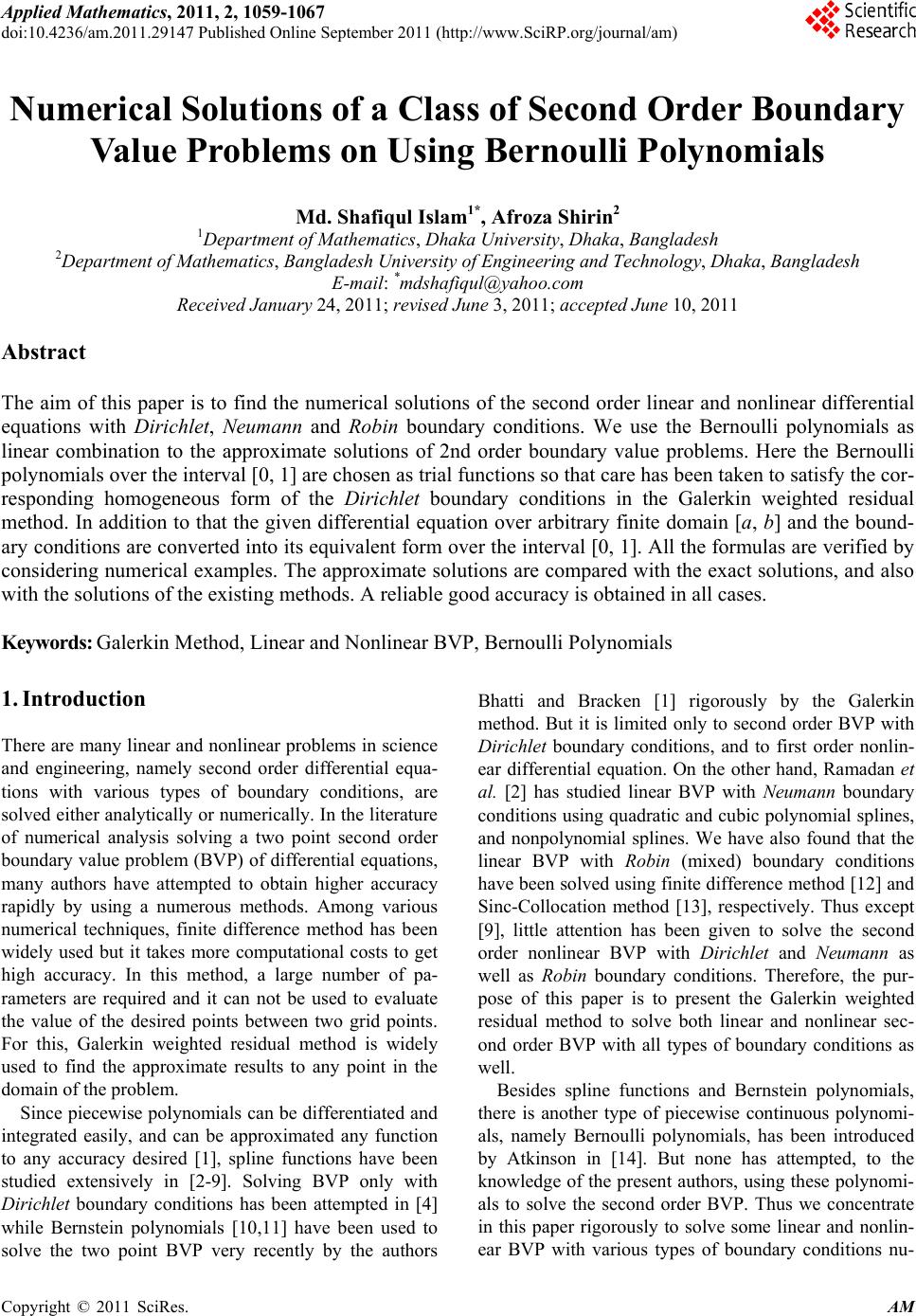 Applied Mathematics, 2011, 2, 1059-1067 doi:10.4236/am.2011.29147 Published Online September 2011 (http://www.SciRP.org/journal/am) Copyright © 2011 SciRes. AM Numerical Solutions of a Class of Second Order Boundary Value Problems on Using Bernoulli Polynomials Md. Shafiqul Islam1*, Afroza Shirin2 1Department of Mathematics, Dhaka University, Dhaka, Bangladesh 2Department of Mathematics, Bangladesh University of Engineering and Technology, Dhaka, Bangladesh E-mail: *mdshafiqul@yahoo.com Received January 24, 2011; revised June 3, 2011; accepted June 10, 2011 Abstract The aim of this paper is to find the numerical solutions of the second order linear and nonlinear differential equations with Dirichlet, Neumann and Robin boundary conditions. We use the Bernoulli polynomials as linear combination to the approximate solutions of 2nd order boundary value problems. Here the Bernoulli polynomials over the interval [0, 1] are chosen as trial functions so that care has been taken to satisfy the cor- responding homogeneous form of the Dirichlet boundary conditions in the Galerkin weighted residual method. In addition to that the given differential equation over arbitrary finite domain [a, b] and the bound- ary conditions are converted into its equivalent form over the interval [0, 1]. All the formulas are verified by considering numerical examples. The approximate solutions are compared with the exact solutions, and also with the solutions of the existing methods. A reliable good accuracy is obtained in all cases. Keywords: Galerkin Method, Linear and Nonlinear BVP, Bernoulli Polynomials 1. Introduction There are many linear and nonlinear problems in science and engineering, namely second order differential equa- tions with various types of boundary conditions, are solved either analytically or numerically. In the literature of numerical analysis solving a two point second order boundary value problem (BVP) of differential equations, many authors have attempted to obtain higher accuracy rapidly by using a numerous methods. Among various numerical techniques, finite difference method has been widely used but it takes more computational costs to get high accuracy. In this method, a large number of pa- rameters are required and it can not be used to evaluate the value of the desired points between two grid points. For this, Galerkin weighted residual method is widely used to find the approximate results to any point in the domain of the problem. Since piecewise polynomials can be differentiated and integrated easily, and can be approximated any function to any accuracy desired [1], spline functions have been studied extensively in [2-9]. Solving BVP only with Dirichlet boundary conditions has been attempted in [4] while Bernstein polynomials [10,11] have been used to solve the two point BVP very recently by the authors Bhatti and Bracken [1] rigorously by the Galerkin method. But it is limited only to second order BVP with Dirichlet boundary conditions, and to first order nonlin- ear differential equation. On the other hand, Ramadan et al. [2] has studied linear BVP with Neumann boundary conditions using quadratic and cubic polynomial splines, and nonpolynomial splines. We have also found that the linear BVP with Robin (mixed) boundary conditions have been solved using finite difference method [12] and Sinc-Collocation method [13], respectively. Thus except [9], little attention has been given to solve the second order nonlinear BVP with Dirichlet and Neumann as well as Robin boundary conditions. Therefore, the pur- pose of this paper is to present the Galerkin weighted residual method to solve both linear and nonlinear sec- ond order BVP with all types of boundary conditions as well. Besides spline functions and Bernstein polynomials, there is another type of piecewise continuous polynomi- als, namely Bernoulli polynomials, has been introduced by Atkinson in [14]. But none has attempted, to the knowledge of the present authors, using these polynomi- als to solve the second order BVP. Thus we concentrate in this paper rigorously to solve some linear and nonlin- ear BVP with various types of boundary conditions nu-  MD. S. ISLAM ET AL. 1060 k 1 merically, though it is originated in [1]. However, in this paper, we first give an introduction of Bernoulli polynomials, and then we formulate the Galer- kin approximation method using Bernoulli polynomials. We derive the individual formulas for each BVP con- sisting of Dirichlet, Neumann and Robin boundary con- ditions, respectively. Numerical examples, for both linear and nonlinear boundary value problems, are considered to verify the effectiveness of the derived formulas, and are also compared with the exact solutions. All the com- putations are performed by MATHEMATI CA. 2. Bernoulli Polynomials The Bernoulli polynomials [14, p. 284] of degree can be defined over the interval [0, 1] implicitly by n 0 nnk n k n Brxb x k (1a) where, are Bernoulli numbers given by k b 01b and . (1b) 1 0 d kk bBrxxk Also Equation (1) can be written explicitly as 0 00 00 1 11 1 11, 1 mn k m nk mn km nk Br x n Brxx k k n nkm k n 1 m (2) The first 11 Bernoulli polynomials are given bellow: 01Br x 34 5 5 55 63 2 xx x Br xx 1 Br xx 24 56 6 53 22 xx Br xxx 2 2 Br xxx 356 7 7 777 6622 xx x x Br xx 2 3 3 3 22 xx Br xx 24 6 78 8 27144 33 3 xx x Br xxx 23 42Br xxxx 58 37 9 321 9 26 10 52 xxx Br xxxx9 28 46 9 10 315 57 5 22 xx Br xxxxx 10 Since Bernoulli polynomials have special properties at 0x and 1x : 00Br , n , and 1n Br 10, n 2n respectively, so that they can be used as a set of basis functions to satisfy the corresponding homogeneous form of the Dirichlet boundary conditions to derive the matrix formulation of second order BVP over the interval [0,1]. 3. Formulation of Second Order BVP We consider the general second order linear BVP [15]: dd , dd u pxqxu rx xx (3a) ,axb 01 ',uau ac 1 , (3b) 01 'ubu bc 2 where ,px qx and rx are specified continuous functions, and 0 , 1 , 0 , 1 , 1, 2 are specified numbers. Since our aim is to use the Bernoulli polyno- mials as trial functions which are derived over the inter- val [0,1], so the BVP (3) is to be converted to an equiva- lent problem on [0,1] by replacing c c by xaba , and thus we have: dd ,0 1 dd u pxqxu rxx xx (4a) 11 010 0'0,1'1uucuu ba ba 2 c (4b) where, 2 1, , pxp b axa ba qxqb axa rxr b ax a (4c) Using Bernoulli polynomials, in Equation (2), we assume an approximate solution in a form, i Br x 0 , n ii i uxaBr x (5) 1,n Now the weighted residual equations corresponding to the differential Equation (4a) given by 1 0 dd d0 dd 1,2, 3,, j u pxqxu rxBr xx xx jn , (6) 4 Since from (5), we have Copyright © 2011 SciRes. AM  MD. S. ISLAM ET AL.1061 0 00 d d, dd 00and1 n i i i n ii ii ii Br ua xx ua Brua Br 1 n After minor simplification, from (6) we can obtain 1 00 0 1 0 1 1 2 1 0 1 1 d dd dd 11 1 00 0 11 d 00 nj i ij i ij ij i j j j Br Br pxqxBr xBrxx xx bap BrBr bap BrBra cbap Br rxBr xx cbapBr (7) or, equivalently in matrix form, , 0 ,0,1,2,, n ij ij i DaF jn (8a) where, 1 , 0 0 1 0 1 d dd dd 11 1 00 0 ,0,1,2,, j i iji j ij ij Br Br DpxqxBrxBrx xx bapBrBr bap BrBr ij n x (8b) 1 2 1 0 1 1 11 d 00 , 0,1, 2,, j jj j cbapBr FrxBrxx cbapBr jn (8c) Solving the system (8a), we find the values of the pa- rameters , and then substituting these parameters in (5), we get the approximate solution of the 0,1,2,, i ai n BVP (4). If we replace x by a ba in ux, then we get the desired approximate solution of the BVP (3). The absolute error, of this formulation is defined by E Euxux. Now we discuss the various types of BVP using dif- ferent boundary conditions as follows: Case 1: The matrix formulation with the Robin (mixed) boundary conditions, (i.e., 00 ,10, 00, 10 ), are already defined in Equations (8). Case 2: The matrix formulation of the differential equation (3a) with the Dirichlet boundary conditions (i.e., 00 , 10, 00, 10 ), is given by , 2 , n ij ij i DaF 2, 3,,jn (9a) where, 1 , 0 d dd, dd ,2,3,,. j i iji j Br Br DpxqxBrxBrx xx ij n x (9b) 1 0 1 0 0 0 d d dd, dd 2,3, , jj j j FrxBrxx Br pxqxxBrxx xx jn (9c) Case 3: The approximate solution of the differential equation (3a) consisting of Neumann boundary condi- tions (i.e., 00a , 10a , 00, 10, ) can be ob- tained by putting 00a and 00, in the Equation (8) as , 0 ,0,1,2,, n ij ij i DaFj n (10a) where 1 , 0 d dd, dd ,0,1,2,, j i iji j Br Br Dpx qxBrxBrx xx ij n x (10b) 1 2 1 0 1 1 11 d 00 , 0,1, 2,, j jj j cbapBr FrxBrxx cb apBr jn (10c) Similar formulation for nonlinear BVP using the Ber- noulli polynomials can be derived, which will be dis- cussed through numerical examples in the next section. 4. Numerical Examples In this section, we explain four linear and two nonlinear boundary value problems which are available in the ex- isting literatures, considering three types of boundary conditions to verify the effectiveness of the present for- Copyright © 2011 SciRes. AM  MD. S. ISLAM ET AL. 1062 mulations described in the previous sections. The con- vergence of each linear BVP is calculated by 1nn Eu xux , where denotes the approximate solution by the proposed method using n-th degree polynomial ap- proximation. The convergence of nonlinear BVP is as- sumed when the absolute error of two consecutive itera- tions is recorded below the convergence criterion n ux such that 1 NN uu where is the Newton’s iteration number and N varies from . 8 10 Example 1. First we consider the BVP with Robin boundary conditions [15]: 2 2 d2cos,π2π d uux x x (11a) π23π21,π4π4uu uu , (11b) and the exact solution is . cosux x The BVP (11) over [0,1] is equivalently to the BVP 2 22 1d ππ 2cos, 01 22 d π2 uux x x (12a) 22 0301,141 4 ππ uu uu (12b) Using the formula derived in equations (8) and using different number of Bernoulli polynomials, the approxi- mate solutions are summarized in Table 1. It is observed that the accuracy is found nearly the order 69 10, 10 and on using 5, 7 and 9 Bernoulli polynomials, respectively. 11 10 Example 2. We consider the BVP with Dirichlet boundary conditions [1]: 2 2 2 de,0 10 d x uux x x (13a) 00, 100uu (13b) The exact solution is: 2 10 1e 2 cot10121cos e10 12ecos 2esin 22e x xx c xx x The BVP (13) is equivalent to the BVP 2 210 2 1d 100e,01 100 d x uux x x (14a) 01uu0, (14b) Using the formula derived in Equations (9), the ap- proximate solutions, shown in Table 2, are obtained using 8, 10 and 15 Bernoulli polynomials with accuracy up to 3, 4 and 6 significant digits, respectively. It is observed that using 21 Bernstein polynomials, the accuracy is found nearly the order of 5 10 in [1]. Example 3. In this case we consider the BVP with Dirichlet boundary conditions [4]: 2 22 d21 ,2 3 d uu x xx x (15a) 20, 3uu 0 (15b) The exact solution is: 2 13 519 38 uxxx6 The BVP (15) is equivalent to the BVP 2 22 d2 1 , 2 d2 uux xx 01 (16a) ,x 00, 1uu 0 (16b) Using the formula derived in Equations (9), the ap- proximate solutions, shown in Table 3, are obtained on using 5, 7 and 10 Bernoulli polynomials, and the accuracy is observed nearly 7, 8 and 9 decimal places, respectively. On the contrary, the error is obtained nearly 10 10 by Arshad [10] with 132h , where hbaN , a and b are the endpoints of the domain and N is the number of subdivision of intervals [a,b]. Example 4. We consider the BVP with Neumann boundary conditions [2]: 2 2 d1,01 d uu xx (17a) 1cos1 1cos1 0,1 sin1 sin1 uu (17b) whose exact solution is, 1cos1 cossin 1 sin1 ux xx . Using the formula given in Equations (10), the ap- proximate solutions, shown in Table 4, are obtained on using 5, 7 and 10 Bernoulli polynomials with the re- markable accuracy nearly the order of and 71 10, 10 0 14 10 . On the other hand, Ramadan et al. [6] has found nearly the accuracy of order 10 , and 66 10 and 8 10 on using quadratic and cubic polynomial splines, and nonpolynomial spline, respectively with 1128h , where hbaN , a and b are the endpoints of the domain and N is the number of subdivision of intervals [a,b]. Copyright © 2011 SciRes. AM 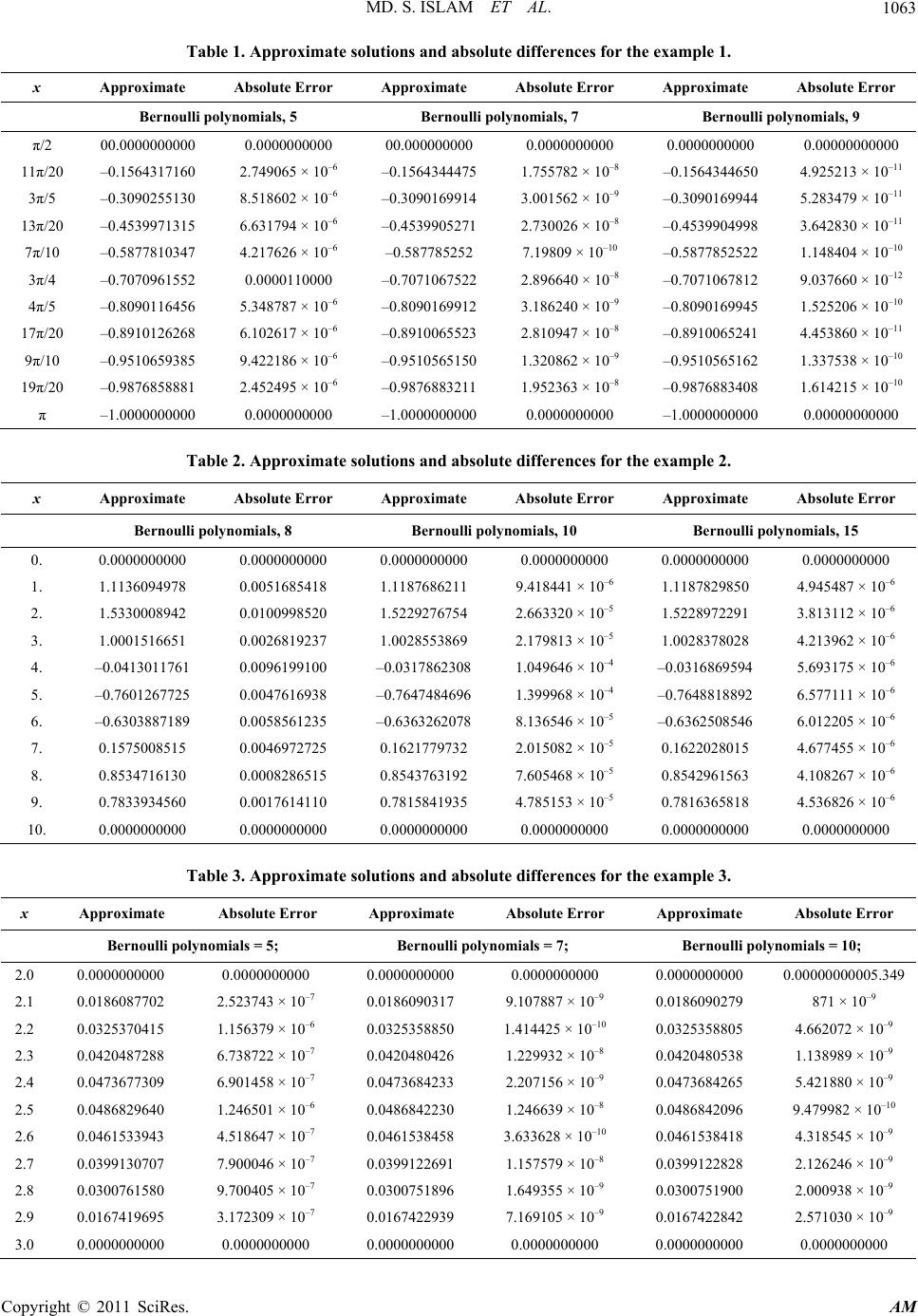 MD. S. ISLAM ET AL. Copyright © 2011 SciRes. AM 1063 Table 1. Approximate solutions and absolute differences for the example 1. x Approximate Absolute Error Approximate Absolute Error Approximate Absolute Error Bernoulli polynomials, 5 Bernoulli polynomials, 7 Bernoulli polynomials, 9 π/2 00.0000000000 0.0000000000 00.000000000 0.0000000000 0.0000000000 0.00000000000 11π/20 –0.1564317160 2.749065 × 10–6 –0.1564344475 1.755782 × 10–8 –0.1564344650 4.925213 × 10–11 3π/5 –0.3090255130 8.518602 × 10–6 –0.3090169914 3.001562 × 10–9 –0.3090169944 5.283479 × 10–11 13π/20 –0.4539971315 6.631794 × 10–6 –0.4539905271 2.730026 × 10–8 –0.4539904998 3.642830 × 10–11 7π/10 –0.5877810347 4.217626 × 10–6 –0.587785252 7.19809 × 10–10 –0.5877852522 1.148404 × 10–10 3π/4 –0.7070961552 0.0000110000 –0.7071067522 2.896640 × 10–8 –0.7071067812 9.037660 × 10–12 4π/5 –0.8090116456 5.348787 × 10–6 –0.8090169912 3.186240 × 10–9 –0.8090169945 1.525206 × 10–10 17π/20 –0.8910126268 6.102617 × 10–6 –0.8910065523 2.810947 × 10–8 –0.8910065241 4.453860 × 10–11 9π/10 –0.9510659385 9.422186 × 10–6 –0.9510565150 1.320862 × 10–9 –0.9510565162 1.337538 × 10–10 19π/20 –0.9876858881 2.452495 × 10–6 –0.9876883211 1.952363 × 10–8 –0.9876883408 1.614215 × 10–10 π –1.0000000000 0.0000000000 –1.0000000000 0.0000000000 –1.0000000000 0.00000000000 Table 2. Approximate solutions and absolute differences for the example 2. x Approximate Absolute Error Approximate Absolute Error Approximate Absolute Error Bernoulli polynomials, 8 Bernoulli polynomials, 10 Bernoulli polynomials, 15 0. 0.0000000000 0.0000000000 0.0000000000 0.0000000000 0.0000000000 0.0000000000 1. 1.1136094978 0.0051685418 1.1187686211 9.418441 × 10–6 1.1187829850 4.945487 × 10–6 2. 1.5330008942 0.0100998520 1.5229276754 2.663320 × 10–5 1.5228972291 3.813112 × 10–6 3. 1.0001516651 0.0026819237 1.0028553869 2.179813 × 10–5 1.0028378028 4.213962 × 10–6 4. –0.0413011761 0.0096199100 –0.0317862308 1.049646 × 10–4 –0.0316869594 5.693175 × 10–6 5. –0.7601267725 0.0047616938 –0.7647484696 1.399968 × 10–4 –0.7648818892 6.577111 × 10–6 6. –0.6303887189 0.0058561235 –0.6363262078 8.136546 × 10–5 –0.6362508546 6.012205 × 10–6 7. 0.1575008515 0.0046972725 0.1621779732 2.015082 × 10–5 0.1622028015 4.677455 × 10–6 8. 0.8534716130 0.0008286515 0.8543763192 7.605468 × 10–5 0.8542961563 4.108267 × 10–6 9. 0.7833934560 0.0017614110 0.7815841935 4.785153 × 10–5 0.7816365818 4.536826 × 10–6 10. 0.0000000000 0.0000000000 0.0000000000 0.0000000000 0.0000000000 0.0000000000 Table 3. Approximate solutions and absolute differences for the example 3. x Approximate Absolute Error Approximate Absolute Error Approximate Absolute Error Bernoulli polynomials = 5; Bernoulli polynomials = 7; Bernoulli polynomials = 10; 2.0 0.0000000000 0.0000000000 0.0000000000 0.0000000000 0.0000000000 0.00000000005.349 2.1 0.0186087702 2.523743 × 10–7 0.0186090317 9.107887 × 10–9 0.0186090279 871 × 10–9 2.2 0.0325370415 1.156379 × 10–6 0.0325358850 1.414425 × 10–10 0.0325358805 4.662072 × 10–9 2.3 0.0420487288 6.738722 × 10–7 0.0420480426 1.229932 × 10–8 0.0420480538 1.138989 × 10–9 2.4 0.0473677309 6.901458 × 10–7 0.0473684233 2.207156 × 10–9 0.0473684265 5.421880 × 10–9 2.5 0.0486829640 1.246501 × 10–6 0.0486842230 1.246639 × 10–8 0.0486842096 9.479982 × 10–10 2.6 0.0461533943 4.518647 × 10–7 0.0461538458 3.633628 × 10–10 0.0461538418 4.318545 × 10–9 2.7 0.0399130707 7.900046 × 10–7 0.0399122691 1.157579 × 10–8 0.0399122828 2.126246 × 10–9 2.8 0.0300761580 9.700405 × 10–7 0.0300751896 1.649355 × 10–9 0.0300751900 2.000938 × 10–9 2.9 0.0167419695 3.172309 × 10–7 0.0167422939 7.169105 × 10–9 0.0167422842 2.571030 × 10–9 3.0 0.0000000000 0.0000000000 0.0000000000 0.0000000000 0.0000000000 0.0000000000 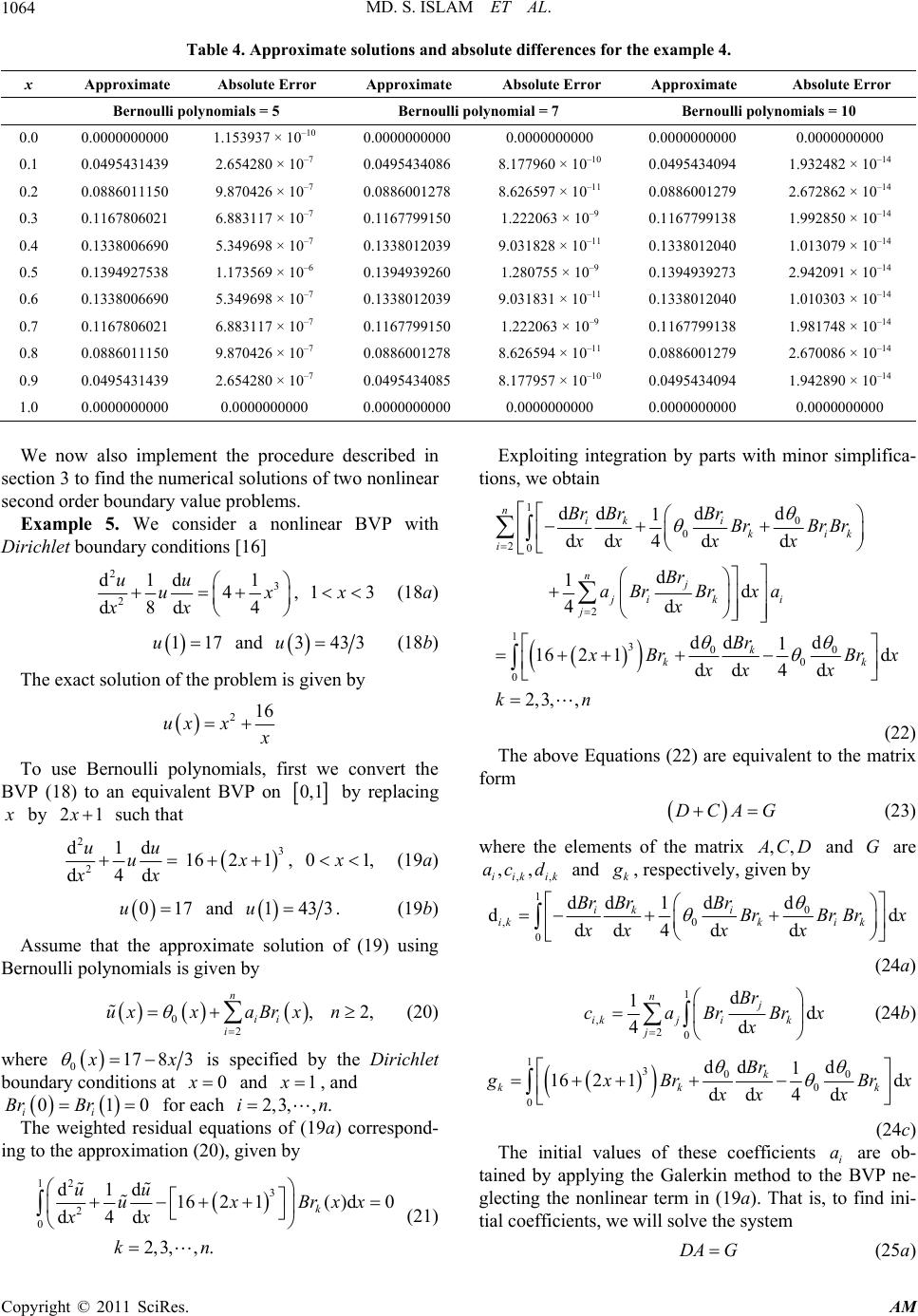 MD. S. ISLAM ET AL. 1064 Table 4. Approximate solutions and absolute differences for the example 4. x Approximate Absolute Error Approximate Absolute Error Approximate Absolute Error Bernoulli polynomials = 5 Bernoulli polynomial = 7 Bernoulli polynomials = 10 0.0 0.0000000000 1.153937 × 10–10 0.0000000000 0.0000000000 0.0000000000 0.0000000000 0.1 0.0495431439 2.654280 × 10–7 0.0495434086 8.177960 × 10–10 0.0495434094 1.932482 × 10–14 0.2 0.0886011150 9.870426 × 10–7 0.0886001278 8.626597 × 10–11 0.0886001279 2.672862 × 10–14 0.3 0.1167806021 6.883117 × 10–7 0.1167799150 1.222063 × 10–9 0.1167799138 1.992850 × 10–14 0.4 0.1338006690 5.349698 × 10–7 0.1338012039 9.031828 × 10–11 0.1338012040 1.013079 × 10–14 0.5 0.1394927538 1.173569 × 10–6 0.1394939260 1.280755 × 10–9 0.1394939273 2.942091 × 10–14 0.6 0.1338006690 5.349698 × 10–7 0.1338012039 9.031831 × 10–11 0.1338012040 1.010303 × 10–14 0.7 0.1167806021 6.883117 × 10–7 0.1167799150 1.222063 × 10–9 0.1167799138 1.981748 × 10–14 0.8 0.0886011150 9.870426 × 10–7 0.0886001278 8.626594 × 10–11 0.0886001279 2.670086 × 10–14 0.9 0.0495431439 2.654280 × 10–7 0.0495434085 8.177957 × 10–10 0.0495434094 1.942890 × 10–14 1.0 0.0000000000 0.0000000000 0.0000000000 0.0000000000 0.0000000000 0.0000000000 We now also implement the procedure described in section 3 to find the numerical solutions of two nonlinear second order boundary value problems. Example 5. We consider a nonlinear BVP with Dirichlet boundary conditions [16] 2 3 2 d1d 1 4 8d 4 d uu ux x x , (18a) 1x3 117u and 3433u (18b) The exact solution of the problem is given by 216 ux x To use Bernoulli polynomials, first we convert the BVP (18) to an equivalent BVP on 0,1 by replacing by 21 such that 23 2 d1d 16 21 4d d uu ux x x , (19a) 0x1, 017u and 143u3. (19b) Assume that the approximate solution of (19) using Bernoulli polynomials is given by 0 2 , n ii i uxxaBr x (20) 2,n where 017 8 3 x is specified by the Dirichlet boundary conditions at and , and for each 0x1x 3, ,in 01 ii Br Br02, . The weighted residual equations of (19a) correspond- ing to the approximation (20), given by 123 2 0 d1d 1621()d0 4d d 2, 3,,. k uu uxBrx x x kn Exploiting integration by parts with minor simplifica- tions, we obtain 1 0 0 20 2 1300 0 0 ddd d 1 dd 4dd d 1d 4d dd d 1 16 21d dd 4d 2,3,, n iki kik i nj jik i j k kk BrBrBrBrBr Br xxxx Br aBrBrxa x Br BrBrx xx x kn (22) The above Equations (22) are equivalent to the matrix form DCAG (23) where the elements of the matrix ,, CD and G are and ,, ,, iikik ac dk , respectively, given by 1 0 ,0 0 ddd d 1 dd dd 4dd ik i ikki k BrBrBr BrBr Brx xxxx (24a) 1 , 20 d 1d 4d nj ikj ik j Br caBrBr x x (24b) 1300 0 0 dd d 1 16 21d dd 4d k kk Br k xBrBr xx x x (24c) x (21) The initial values of these coefficients i are ob- tained by applying the Galerkin method to the BVP ne- glecting the nonlinear term in (19a). That is, to find ini- tial coefficients, we will solve the system a DA G (25a) Copyright © 2011 SciRes. AM 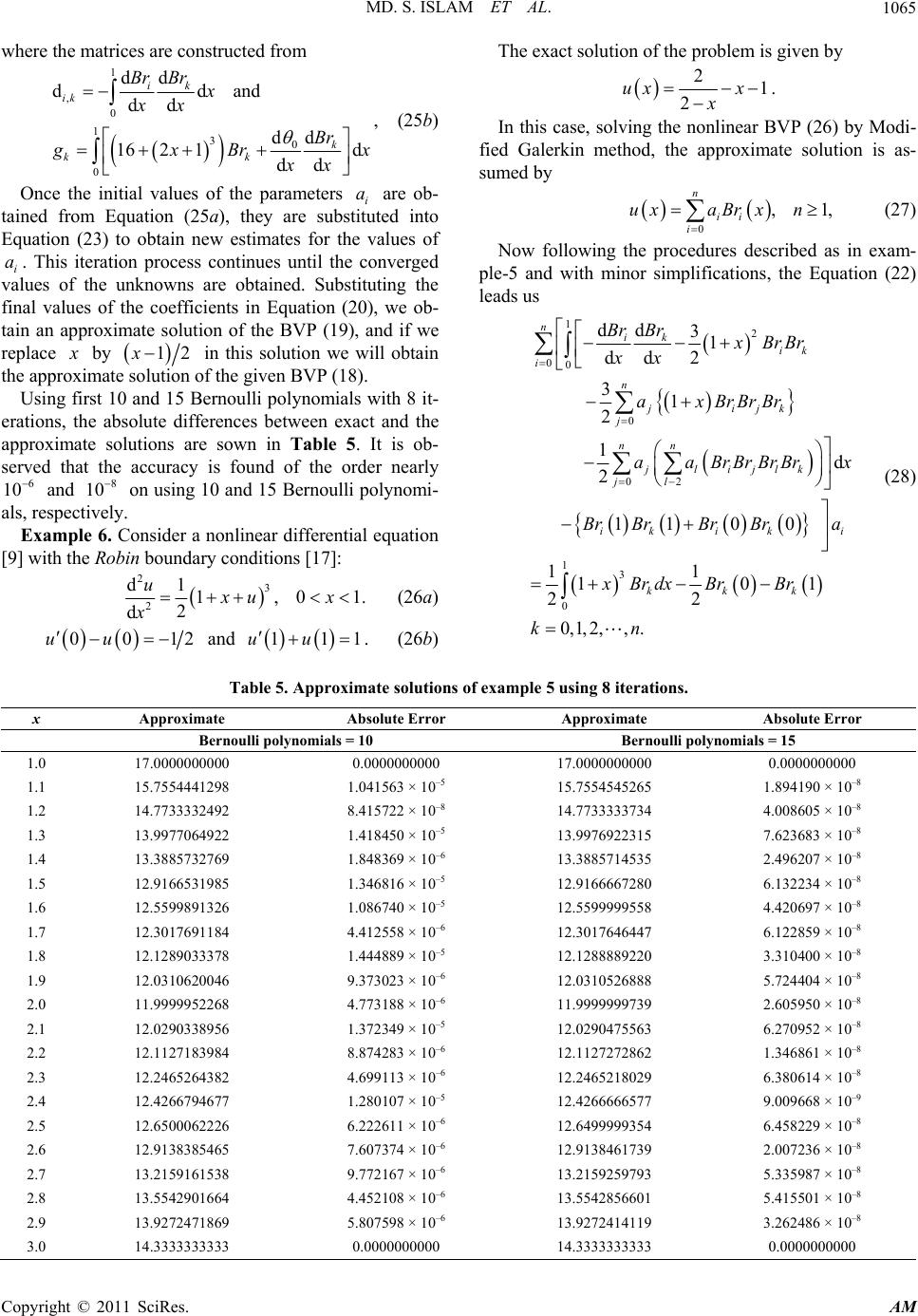 MD. S. ISLAM ET AL.1065 where the matrices are constructed from 1 , 0 130 0 dd ddand dd dd 16 21d dd ik ik k kk Br Brx xx Br xBr xx x , (25b) Once the initial values of the parameters i are ob- tained from Equation (25a), they are substituted into Equation (23) to obtain new estimates for the values of i. This iteration process continues until the converged values of the unknowns are obtained. Substituting the final values of the coefficients in Equation (20), we ob- tain an approximate solution of the BVP (19), and if we replace a a by 12x in this solution we will obtain the approximate solution of the given BVP (18). Using first 10 and 15 Bernoulli polynomials with 8 it- erations, the absolute differences between exact and the approximate solutions are sown in Table 5. It is ob- served that the accuracy is found of the order nearly and on using 10 and 15 Bernoulli polynomi- als, respectively. 6 108 10 Example 6. Consider a nonlinear differential equation [9] with the Robi n boundary conditions [17]: 23 2 d1 1, 2 d u u x (26a) 0x1. 001uu The exact solution of the problem is given by 21 2 ux x x . In this case, solving the nonlinear BVP (26) by Modi- fied Galerkin method, the approximate solution is as- sumed by 0 , n ii i uxaBr x (27) 1,n Now following the procedures described as in exam- ple-5 and with minor simplifications, the Equation (22) leads us 12 00 0 02 13 0 dd 31 dd 2 31 2 1d 2 110 0 11 10 22 0,1, 2,,. n ik ik i n jijk j nn jlijlk jl ikik kkk Br BrxBrBr xx axBr BrBr aaBrBrBrBrx Br BrBrBra xBrdx BrBr kn 1 i (28) 21 and . (26b) 11uu Table 5. Approximate solutions of example 5 using 8 iterations. x Approximate Absolute Error Approximate Absolute Error Bernoulli polynomials = 10 Bernoulli polynomials = 15 1.0 17.0000000000 0.0000000000 17.0000000000 0.0000000000 1.1 15.7554441298 1.041563 × 10–5 15.7554545265 1.894190 × 10–8 1.2 14.7733332492 8.415722 × 10–8 14.7733333734 4.008605 × 10–8 1.3 13.9977064922 1.418450 × 10–5 13.9976922315 7.623683 × 10–8 1.4 13.3885732769 1.848369 × 10–6 13.3885714535 2.496207 × 10–8 1.5 12.9166531985 1.346816 × 10–5 12.9166667280 6.132234 × 10–8 1.6 12.5599891326 1.086740 × 10–5 12.5599999558 4.420697 × 10–8 1.7 12.3017691184 4.412558 × 10–6 12.3017646447 6.122859 × 10–8 1.8 12.1289033378 1.444889 × 10–5 12.1288889220 3.310400 × 10–8 1.9 12.0310620046 9.373023 × 10–6 12.0310526888 5.724404 × 10–8 2.0 11.9999952268 4.773188 × 10–6 11.9999999739 2.605950 × 10–8 2.1 12.0290338956 1.372349 × 10–5 12.0290475563 6.270952 × 10–8 2.2 12.1127183984 8.874283 × 10–6 12.1127272862 1.346861 × 10–8 2.3 12.2465264382 4.699113 × 10–6 12.2465218029 6.380614 × 10–8 2.4 12.4266794677 1.280107 × 10–5 12.4266666577 9.009668 × 10–9 2.5 12.6500062226 6.222611 × 10–6 12.6499999354 6.458229 × 10–8 2.6 12.9138385465 7.607374 × 10–6 12.9138461739 2.007236 × 10–8 2.7 13.2159161538 9.772167 × 10–6 13.2159259793 5.335987 × 10–8 2.8 13.5542901664 4.452108 × 10–6 13.5542856601 5.415501 × 10–8 2.9 13.9272471869 5.807598 × 10–6 13.9272414119 3.262486 × 10–8 3.0 14.3333333333 0.0000000000 14.3333333333 0.0000000000 Copyright © 2011 SciRes. AM 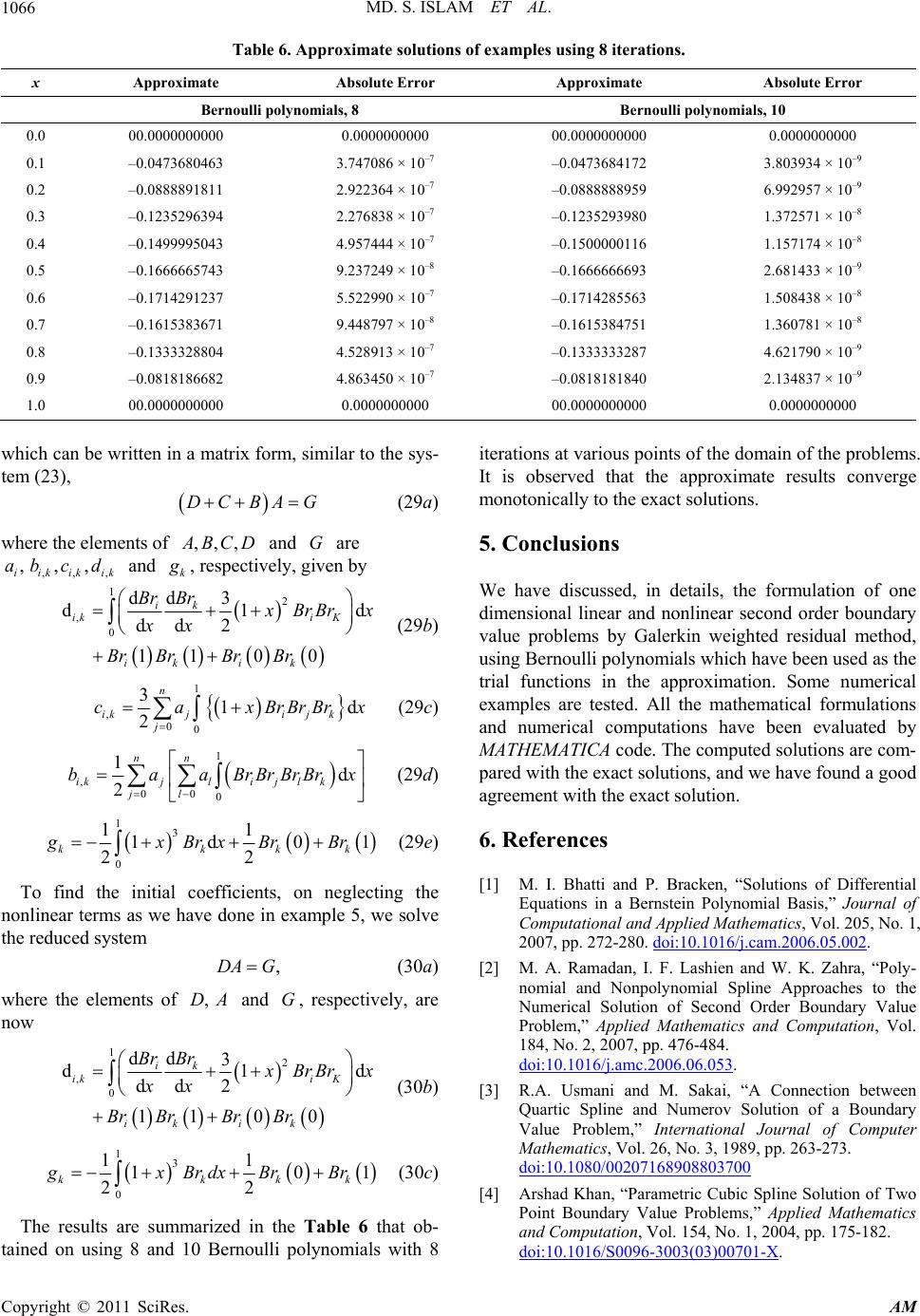 MD. S. ISLAM ET AL. 1066 Table 6. Approximate solutions of examples using 8 iterations. x Approximate Absolute Error Approximate Absolute Error Bernoulli polynomials, 8 Bernoulli polynomials, 10 0.0 00.0000000000 0.0000000000 00.0000000000 0.0000000000 0.1 –0.0473680463 3.747086 × 10–7 –0.0473684172 3.803934 × 10–9 0.2 –0.0888891811 2.922364 × 10–7 –0.0888888959 6.992957 × 10–9 0.3 –0.1235296394 2.276838 × 10–7 –0.1235293980 1.372571 × 10–8 0.4 –0.1499995043 4.957444 × 10–7 –0.1500000116 1.157174 × 10–8 0.5 –0.1666665743 9.237249 × 10–8 –0.1666666693 2.681433 × 10–9 0.6 –0.1714291237 5.522990 × 10–7 –0.1714285563 1.508438 × 10–8 0.7 –0.1615383671 9.448797 × 10–8 –0.1615384751 1.360781 × 10–8 0.8 –0.1333328804 4.528913 × 10–7 –0.1333333287 4.621790 × 10–9 0.9 –0.0818186682 4.863450 × 10–7 –0.0818181840 2.134837 × 10–9 1.0 00.0000000000 0.0000000000 00.0000000000 0.0000000000 which can be written in a matrix form, similar to the sys- tem (23), DCBAG (29a) where the elements of ,,, BCD k and G are and ,, , ,,, iikikik ab cd , respectively, given by 12 , 0 dd 3 d1d dd2 1100 ik iki K ikik Br Br Br Brx xx Br BrBrBr (29b) 1 , 00 31d 2 n ikjij k j caxBrBrBr x (29c) 1 , 00 0 1d 2 nn ikjlij lk jl baaBrBrBrBr x (29d) 13 0 11 1d 0 22 kkk gxBrxBrB 1 k r (29e) To find the initial coefficients, on neglecting the nonlinear terms as we have done in example 5, we solve the reduced system ,DA G (30a) where the elements of and , respectively, are now ,DA G 12 , 0 dd 3 d1 dd2 1100 ik iki K ikik Br Brd Br Brx xx Br BrBrBr (30b) 13 0 11 10 22 kkk gxBr dxBrBr 1 k (30c) The results are summarized in the Table 6 that ob- tained on using 8 and 10 Bernoulli polynomials with 8 iterations at various points of the domain of the problems. It is observed that the approximate results converge monotonically to the exact solutions. 5. Conclusions We have discussed, in details, the formulation of one dimensional linear and nonlinear second order boundary value problems by Galerkin weighted residual method, using Bernoulli polynomials which have been used as the trial functions in the approximation. Some numerical examples are tested. All the mathematical formulations and numerical computations have been evaluated by MATHEMATICA code. The computed solutions are com- pared with the exact solutions, and we have found a good agreement with the exact solution. 6. References [1] M. I. Bhatti and P. Bracken, “Solutions of Differential Equations in a Bernstein Polynomial Basis,” Journal of Computational and Applied Mathematics, Vol. 205, No. 1, 2007, pp. 272-280. doi:10.1016/j.cam.2006.05.002. [2] M. A. Ramadan, I. F. Lashien and W. K. Zahra, “Poly- nomial and Nonpolynomial Spline Approaches to the Numerical Solution of Second Order Boundary Value Problem,” Applied Mathematics and Computation, Vol. 184, No. 2, 2007, pp. 476-484. doi:10.1016/j.amc.2006.06.053. [3] R.A. Usmani and M. Sakai, “A Connection between Quartic Spline and Numerov Solution of a Boundary Value Problem,” International Journal of Computer Mathematics, Vol. 26, No. 3, 1989, pp. 263-273. doi:10.1080/00207168908803700 [4] Arshad Khan, “Parametric Cubic Spline Solution of Two Point Boundary Value Problems,” Applied Mathematics and Computation, Vol. 154, No. 1, 2004, pp. 175-182. doi:10.1016/S0096-3003(03)00701-X. Copyright © 2011 SciRes. AM 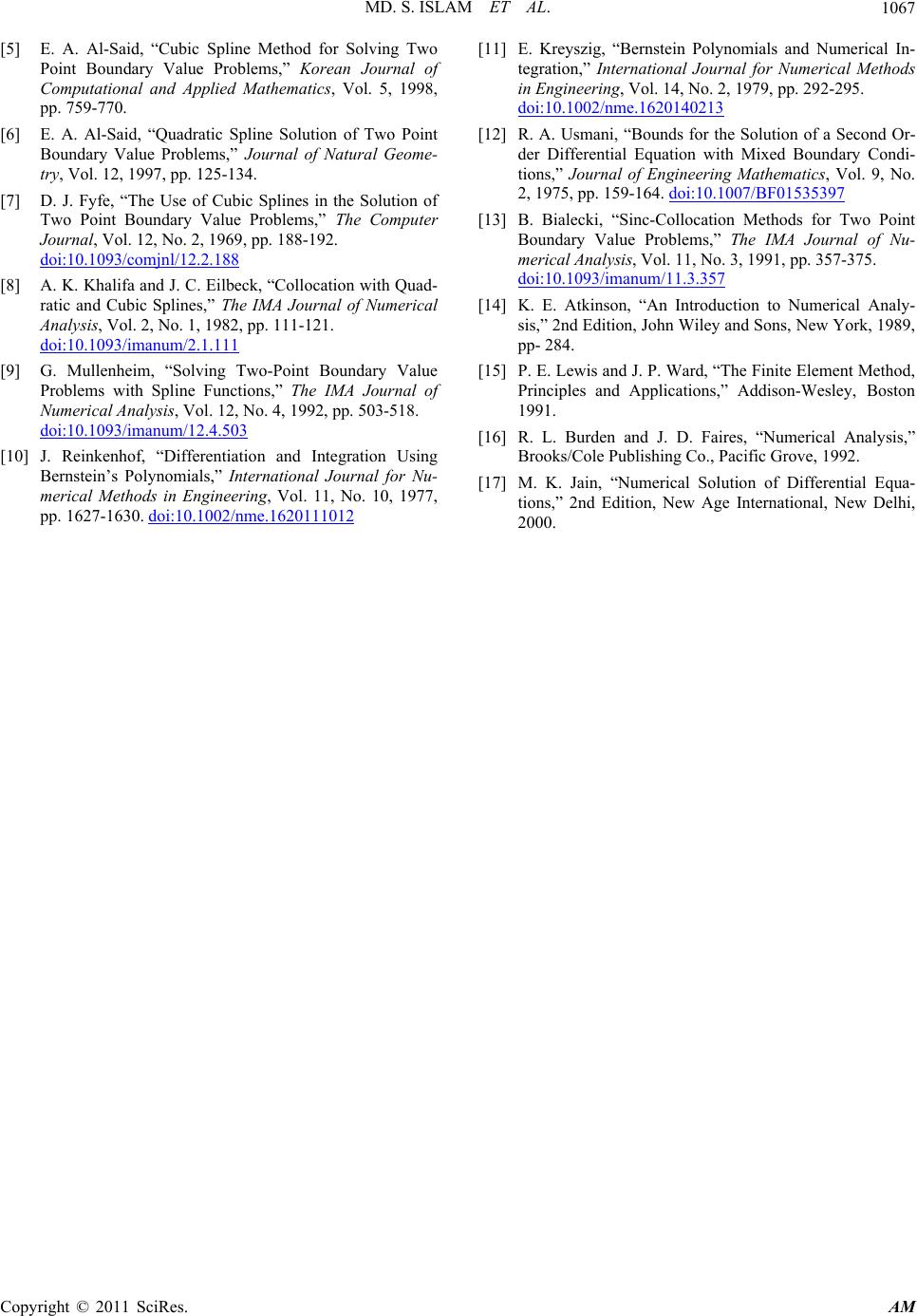 MD. S. ISLAM ET AL.1067 [5] E. A. Al-Said, “Cubic Spline Method for Solving Two Point Boundary Value Problems,” Korean Journal of Computational and Applied Mathematics, Vol. 5, 1998, pp. 759-770. [6] E. A. Al-Said, “Quadratic Spline Solution of Two Point Boundary Value Problems,” Journal of Natural Geome- try, Vol. 12, 1997, pp. 125-134. [7] D. J. Fyfe, “The Use of Cubic Splines in the Solution of Two Point Boundary Value Problems,” The Computer Journal, Vol. 12, No. 2, 1969, pp. 188-192. doi:10.1093/comjnl/12.2.188 [8] A. K. Khalifa and J. C. Eilbeck, “Collocation with Quad- ratic and Cubic Splines,” The IMA Journal of Numerical Analysis, Vol. 2, No. 1, 1982, pp. 111-121. doi:10.1093/imanum/2.1.111 [9] G. Mullenheim, “Solving Two-Point Boundary Value Problems with Spline Functions,” The IMA Journal of Numerical Analysis, Vol. 12, No. 4, 1992, pp. 503-518. doi:10.1093/imanum/12.4.503 [10] J. Reinkenhof, “Differentiation and Integration Using Bernstein’s Polynomials,” International Journal for Nu- merical Methods in Engineering, Vol. 11, No. 10, 1977, pp. 1627-1630. doi:10.1002/nme.1620111012 [11] E. Kreyszig, “Bernstein Polynomials and Numerical In- tegration,” International Journal for Numerical Methods in Engineering, Vol. 14, No. 2, 1979, pp. 292-295. doi:10.1002/nme.1620140213 [12] R. A. Usmani, “Bounds for the Solution of a Second Or- der Differential Equation with Mixed Boundary Condi- tions,” Journal of Engineering Mathematics, Vol. 9, No. 2, 1975, pp. 159-164. doi:10.1007/BF01535397 [13] B. Bialecki, “Sinc-Collocation Methods for Two Point Boundary Value Problems,” The IMA Journal of Nu- merical Analysis, Vol. 11, No. 3, 1991, pp. 357-375. doi:10.1093/imanum/11.3.357 [14] K. E. Atkinson, “An Introduction to Numerical Analy- sis,” 2nd Edition, John Wiley and Sons, New York, 1989, pp- 284. [15] P. E. Lewis and J. P. Ward, “The Finite Element Method, Principles and Applications,” Addison-Wesley, Boston 1991. [16] R. L. Burden and J. D. Faires, “Numerical Analysis,” Brooks/Cole Publishing Co., Pacific Grove, 1992. [17] M. K. Jain, “Numerical Solution of Differential Equa- tions,” 2nd Edition, New Age International, New Delhi, 2000. Copyright © 2011 SciRes. AM
|